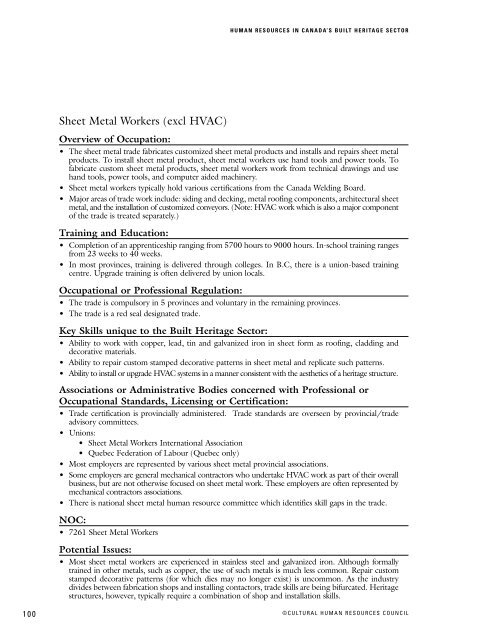Human Resources in Canada's Built Heritage Sector: Mapping the ...
Human Resources in Canada's Built Heritage Sector: Mapping the ...
Human Resources in Canada's Built Heritage Sector: Mapping the ...
- No tags were found...
Create successful ePaper yourself
Turn your PDF publications into a flip-book with our unique Google optimized e-Paper software.
HUMAN RESOURCES IN CANADA’S BUILT HERITAGE SECTORSheet Metal Workers (excl HVAC)Overview of Occupation:• The sheet metal trade fabricates customized sheet metal products and <strong>in</strong>stalls and repairs sheet metalproducts. To <strong>in</strong>stall sheet metal product, sheet metal workers use hand tools and power tools. Tofabricate custom sheet metal products, sheet metal workers work from technical draw<strong>in</strong>gs and usehand tools, power tools, and computer aided mach<strong>in</strong>ery.• Sheet metal workers typically hold various certifications from <strong>the</strong> Canada Weld<strong>in</strong>g Board.• Major areas of trade work <strong>in</strong>clude: sid<strong>in</strong>g and deck<strong>in</strong>g, metal roof<strong>in</strong>g components, architectural sheetmetal, and <strong>the</strong> <strong>in</strong>stallation of customized conveyors. (Note: HVAC work which is also a major componentof <strong>the</strong> trade is treated separately.)Tra<strong>in</strong><strong>in</strong>g and Education:• Completion of an apprenticeship rang<strong>in</strong>g from 5700 hours to 9000 hours. In-school tra<strong>in</strong><strong>in</strong>g rangesfrom 23 weeks to 40 weeks.• In most prov<strong>in</strong>ces, tra<strong>in</strong><strong>in</strong>g is delivered through colleges. In B.C, <strong>the</strong>re is a union-based tra<strong>in</strong><strong>in</strong>gcentre. Upgrade tra<strong>in</strong><strong>in</strong>g is often delivered by union locals.Occupational or Professional Regulation:• The trade is compulsory <strong>in</strong> 5 prov<strong>in</strong>ces and voluntary <strong>in</strong> <strong>the</strong> rema<strong>in</strong><strong>in</strong>g prov<strong>in</strong>ces.• The trade is a red seal designated trade.Key Skills unique to <strong>the</strong> <strong>Built</strong> <strong>Heritage</strong> <strong>Sector</strong>:• Ability to work with copper, lead, t<strong>in</strong> and galvanized iron <strong>in</strong> sheet form as roof<strong>in</strong>g, cladd<strong>in</strong>g anddecorative materials.• Ability to repair custom stamped decorative patterns <strong>in</strong> sheet metal and replicate such patterns.• Ability to <strong>in</strong>stall or upgrade HVAC systems <strong>in</strong> a manner consistent with <strong>the</strong> aes<strong>the</strong>tics of a heritage structure.Associations or Adm<strong>in</strong>istrative Bodies concerned with Professional orOccupational Standards, Licens<strong>in</strong>g or Certification:• Trade certification is prov<strong>in</strong>cially adm<strong>in</strong>istered. Trade standards are overseen by prov<strong>in</strong>cial/tradeadvisory committees.• Unions:• Sheet Metal Workers International Association• Quebec Federation of Labour (Quebec only)• Most employers are represented by various sheet metal prov<strong>in</strong>cial associations.• Some employers are general mechanical contractors who undertake HVAC work as part of <strong>the</strong>ir overallbus<strong>in</strong>ess, but are not o<strong>the</strong>rwise focused on sheet metal work. These employers are often represented bymechanical contractors associations.• There is national sheet metal human resource committee which identifies skill gaps <strong>in</strong> <strong>the</strong> trade.NOC:• 7261 Sheet Metal WorkersPotential Issues:• Most sheet metal workers are experienced <strong>in</strong> sta<strong>in</strong>less steel and galvanized iron. Although formallytra<strong>in</strong>ed <strong>in</strong> o<strong>the</strong>r metals, such as copper, <strong>the</strong> use of such metals is much less common. Repair customstamped decorative patterns (for which dies may no longer exist) is uncommon. As <strong>the</strong> <strong>in</strong>dustrydivides between fabrication shops and <strong>in</strong>stall<strong>in</strong>g contactors, trade skills are be<strong>in</strong>g bifurcated. <strong>Heritage</strong>structures, however, typically require a comb<strong>in</strong>ation of shop and <strong>in</strong>stallation skills.100©CULTURAL HUMAN RESOURCES COUNCIL










